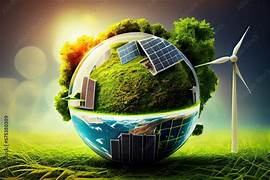The Role of Renewable Energy in Combating Climate Change
Climate change represents one of the most pressing challenges of our time, driven by the excessive release of greenhouse gases (GHGs) into the atmosphere. The primary source of these emissions is the burning of fossil fuels for energy. Transitioning to renewable energy is essential for mitigating the impacts of climate change and building a sustainable future. This article explores the role of renewable energy in combating climate change, examining its benefits, challenges, and potential.
Understanding Renewable Energy
Renewable energy comes from natural sources that are constantly replenished. These include solar, wind, hydropower, geothermal, and biomass energy. Unlike fossil fuels, renewable energy sources emit little to no greenhouse gases during operation, making them environmentally friendly alternatives for energy production.
The Link Between Energy and Climate Change
Fossil fuels such as coal, oil, and natural gas account for the majority of global energy consumption. Their combustion releases large quantities of carbon dioxide (CO2) and other GHGs into the atmosphere, contributing to global warming. According to the International Energy Agency (IEA), energy-related emissions constitute over 70% of global GHG emissions.
Renewable energy offers a pathway to decouple economic growth from GHG emissions. By replacing fossil fuels with renewables, countries can significantly reduce their carbon footprints while meeting energy demands.
Benefits of Renewable Energy in Combating Climate Change
- Reduction in Greenhouse Gas Emissions Renewable energy technologies produce minimal GHGs during operation. For instance, solar panels and wind turbines generate electricity without burning fuels, drastically cutting emissions compared to coal or gas-fired power plants.
- Energy Security By harnessing local renewable resources, countries can reduce their reliance on imported fossil fuels. This enhances energy security and protects economies from volatile fossil fuel prices.
- Sustainable Development Renewable energy projects often bring socio-economic benefits, including job creation and improved energy access. These projects contribute to achieving multiple United Nations Sustainable Development Goals (SDGs), such as affordable and clean energy, decent work, and economic growth.
- Health Benefits Fossil fuel combustion contributes to air pollution, leading to respiratory and cardiovascular diseases. Transitioning to clean energy sources improves air quality and public health.
- Technological Advancements The renewable energy sector drives innovation, leading to improved efficiency and cost reductions. Advances in energy storage, smart grids, and distributed energy systems are enhancing the feasibility of a renewable-based energy system.
Major Renewable Energy Sources
Solar Energy
Solar energy harnesses sunlight to generate electricity through photovoltaic (PV) panels or concentrated solar power (CSP) systems. As the cost of solar technology continues to decline, its adoption has surged worldwide. Solar power is especially beneficial for regions with abundant sunlight and for off-grid applications.
Wind Energy
Wind turbines convert kinetic energy from wind into electricity. Wind energy is one of the fastest-growing renewable energy technologies, with significant potential for large-scale deployment. Offshore wind farms are emerging as a promising avenue for harnessing wind energy.
Hydropower
Hydropower uses the flow of water to generate electricity. It is a mature and reliable renewable energy source, accounting for a significant share of global renewable energy generation. However, large-scale hydropower projects must be managed carefully to minimize ecological and social impacts.
Geothermal Energy
Geothermal energy taps into heat from beneath the Earth’s surface to generate electricity or provide direct heating. It is a stable and sustainable energy source with considerable potential in regions with geothermal activity.
Biomass Energy
Biomass energy is derived from organic materials such as agricultural residues, forestry byproducts, and waste. While it is renewable, the sustainability of biomass energy depends on responsible resource management to avoid deforestation and other environmental impacts.
Challenges in Scaling Up Renewable Energy
- Intermittency and Reliability Solar and wind energy depend on weather conditions, leading to intermittent power generation. Energy storage solutions, such as batteries and pumped hydro, are essential to address this challenge.
- Infrastructure Needs Transitioning to renewable energy requires significant investments in infrastructure, including power grids, storage systems, and charging stations for electric vehicles.
- Cost Barriers While the cost of renewable energy technologies has decreased significantly, initial investment costs can still be a hurdle, particularly for developing countries.
- Land and Resource Use Large-scale renewable energy projects may require significant land and resources, potentially leading to conflicts with agriculture, conservation, and local communities.
- Policy and Regulatory Support Supportive policies and regulatory frameworks are crucial for promoting renewable energy adoption. Inconsistent or inadequate policies can hinder progress.
Global Progress and Success Stories
Countries worldwide are embracing renewable energy to combat climate change. For example:
- Germany has invested heavily in solar and wind energy through its Energiewende policy, aiming to achieve a carbon-neutral economy by 2045.
- China leads the world in renewable energy capacity, with significant investments in solar and wind energy.
- Iceland meets nearly 100% of its electricity needs through renewable energy, leveraging its abundant geothermal and hydropower resources.
- Costa Rica consistently generates over 98% of its electricity from renewable sources, showcasing the potential of a clean energy transition.
The Role of Individuals and Communities
The shift to renewable energy is not solely the responsibility of governments and corporations. Individuals and communities play a crucial role in this transition:
- Adopting Renewable Energy: Installing solar panels or participating in community wind or solar projects can reduce reliance on fossil fuels.
- Energy Efficiency: Using energy-efficient appliances and practices reduces overall energy consumption and complements renewable energy efforts.
- Advocacy and Awareness: Supporting policies and initiatives that promote renewable energy can accelerate the transition.
Looking Ahead: A Renewable Energy Future
Achieving a renewable energy future requires collective action, innovation, and commitment. Governments must set ambitious renewable energy targets, provide incentives, and invest in research and development. The private sector must drive innovation and scale up renewable energy deployment. Individuals must embrace sustainable practices and demand clean energy solutions.
Renewable energy is not just a tool for combating climate change but a cornerstone of a sustainable, equitable, and prosperous future. By harnessing the power of the sun, wind, water, and earth, humanity can address the climate crisis and create a resilient energy system for generations to come.


